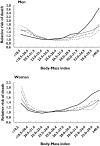New central targets for the treatment of obesity
- PMID: 20002079
- PMCID: PMC2810796
- DOI: 10.1111/j.1365-2125.2009.03550.x
New central targets for the treatment of obesity
Abstract
The review focuses on the central neuronal circuits involved in energy homeostasis and the opportunities these offer for pharmacological intervention to decrease feeding behaviour and reduce weight. This article is based on the presentation 'New central targets for the treatment of obesity' (Sargent, British Pharmacological society, Clinical Section Symposium, December 2008). Central neuronal substrates controlling weight offer numerous opportunities for pharmacological intervention. These opportunities range from non-specific enhancement of monoamine signalling (triple reuptake inhibitors) to targeting specific monoamine receptor subtypes (5-HT(2c) and 5-HT(6)). The data reviewed suggest that these approaches will lead to weight loss; whether this is sufficient to produce clinically meaningful effect remains to be determined. Combination therapy targeting more than one mechanism may be a means of increasing the magnitude of the response. Preclinical studies also suggest that novel approaches targeting specific neuronal pathways within the hypothalamus, e.g. MCH(1) receptor antagonism, offer an opportunity for weight reduction. However, these approaches are at an early stage and clinical studies will be needed to determine if these novel approaches lead to clinically meaningful weight loss and improvements in co-morbid conditions such as diabetes and cardiovascular disorders.
Figures

 )
)
Similar articles
-
[Pharmacological therapy of obesity].G Ital Cardiol (Rome). 2008 Apr;9(4 Suppl 1):83S-93S. G Ital Cardiol (Rome). 2008. PMID: 18773755 Italian.
-
Pharmacology of appetite suppression: implication for the treatment of obesity.Curr Drug Targets. 2001 Dec;2(4):353-70. doi: 10.2174/1389450013348209. Curr Drug Targets. 2001. PMID: 11732637 Review.
-
Pharmacologic management of obesity.Pediatr Blood Cancer. 2012 Jan;58(1):140-3. doi: 10.1002/pbc.23366. Epub 2011 Oct 18. Pediatr Blood Cancer. 2012. PMID: 22009632 Review.
-
Central and peripheral molecular targets for antiobesity pharmacotherapy.Clin Pharmacol Ther. 2010 Jun;87(6):652-62. doi: 10.1038/clpt.2010.57. Epub 2010 May 5. Clin Pharmacol Ther. 2010. PMID: 20445536 Free PMC article.
-
Drug strategies for the treatment of obesity.IDrugs. 2003 Jun;6(6):566-72. IDrugs. 2003. PMID: 12811679 Review.
Cited by
-
Antiobesity pharmacotherapy: new drugs and emerging targets.Clin Pharmacol Ther. 2014 Jan;95(1):53-66. doi: 10.1038/clpt.2013.204. Epub 2013 Oct 8. Clin Pharmacol Ther. 2014. PMID: 24105257 Free PMC article. Review.
-
Editors' pick 2009.Br J Clin Pharmacol. 2010 Feb;69(2):107-10. doi: 10.1111/j.1365-2125.2009.03606.x. Br J Clin Pharmacol. 2010. PMID: 20233172 Free PMC article. No abstract available.
-
Novel Noninvasive Approaches to the Treatment of Obesity: From Pharmacotherapy to Gene Therapy.Endocr Rev. 2022 May 12;43(3):507-557. doi: 10.1210/endrev/bnab034. Endocr Rev. 2022. PMID: 35552683 Free PMC article. Review.
-
Editorial for BJCP Special Obesity Edition.Br J Clin Pharmacol. 2009 Dec;68(6):801-3. doi: 10.1111/j.1365-2125.2009.03582.x. Br J Clin Pharmacol. 2009. PMID: 20002074 Free PMC article. No abstract available.
-
Anti-Obesity Drug Delivery Systems: Recent Progress and Challenges.Pharmaceutics. 2023 Nov 16;15(11):2635. doi: 10.3390/pharmaceutics15112635. Pharmaceutics. 2023. PMID: 38004612 Free PMC article. Review.
References
-
- Center for Disease Control and Prevention. Available at http://www.cdc.gov/nccdphp/dnpa/obesity/trend/maps/ (last accessed.
-
- Calle EE, Thun MJ, Petrelli JM, Rogriguez C, Heath CW. Body-mass index and mortality in a prospective cohort of U.S. adults. N Engl J Med. 1999;341:1097–105. - PubMed
-
- Finkelstein EA, Fiebelkorn IC, Wang G. National medical spending attributable to overweight and obesity: how much, and who's paying? Health Affairs. 2003;W3:219–26. - PubMed
Publication types
MeSH terms
Substances
LinkOut - more resources
Full Text Sources
Other Literature Sources
Medical

